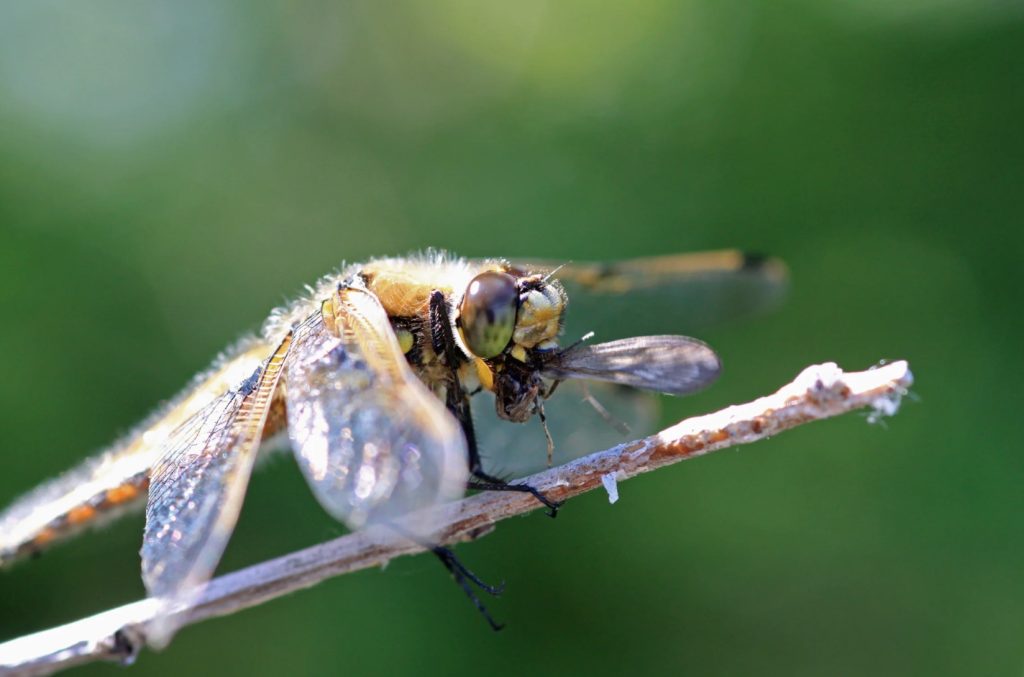
Dragonflies are nature’s mosquito patrol—one dragonfly can eat hundreds of mosquitoes a day.
By planting the right flora, you’ll create a habitat these aerial acrobats love. Here are 15 plants that will transform your yard into a dragonfly magnet.
Please note: This is not a list of pretty plants that attract dragonflies (although there are a few), it’s a list of the MOST EFFECTIVE plants. At the end of the article, I’ve compiled a guide based on my decade-plus of battling mosquitoes on my heavily wooded 3+ acres of land. Enjoy!
1. Marsh Marigold
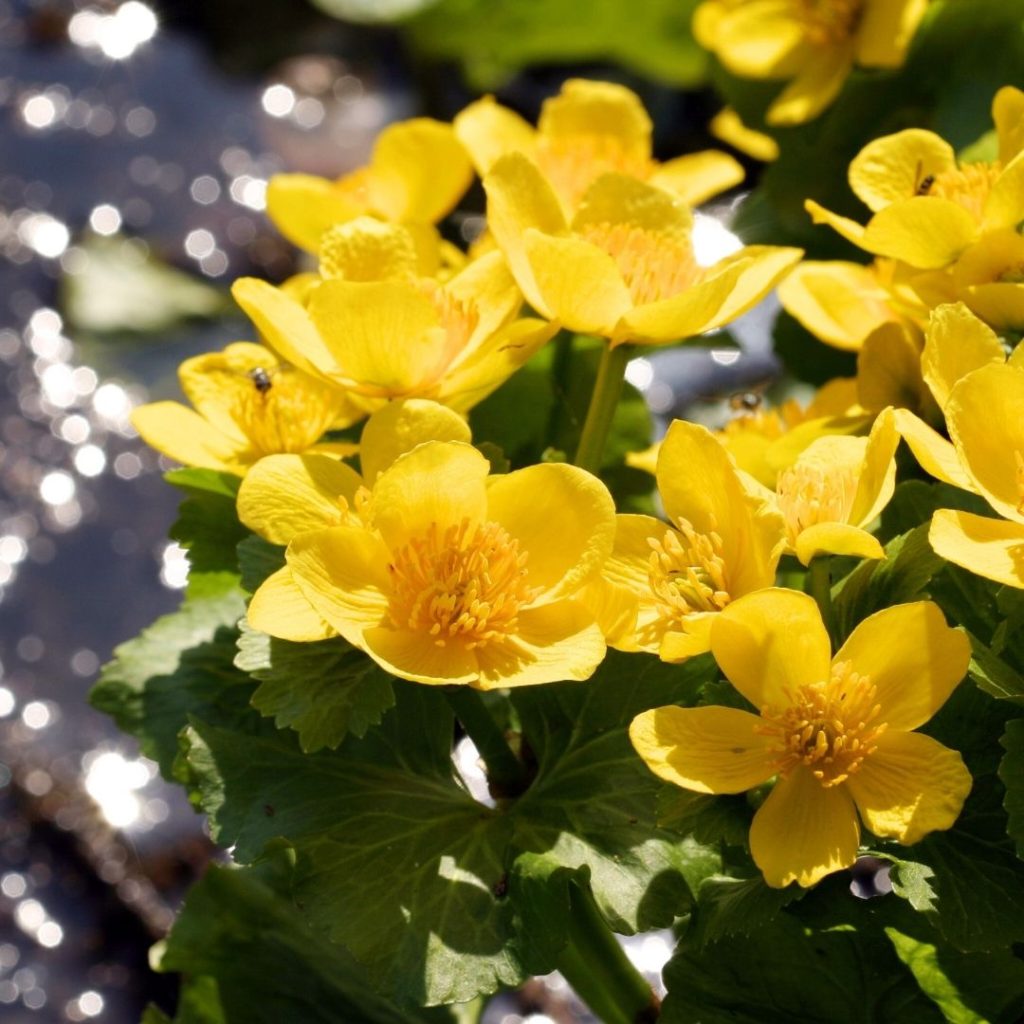
Marsh Marigold’s glossy leaves and golden flowers pop in early spring, giving newly emerged dragonflies sunny perches.
Its dense groundcover shades water, making it less hospitable to mosquito larvae. As a bonus, the bright blooms signal other beneficial insects that your wetland space is open for business.
- Hardiness zones: 3–8
- Companions: Skunk Cabbage, Sedge, Cardinal Flower
- Sun/Shade: Full sun to partial shade
- Attracts: Dragonflies, bees, early pollinators
- Repels: Shade-loving mosquitoes
2. Yellow Flag Iris (Top 5 Most Effective)
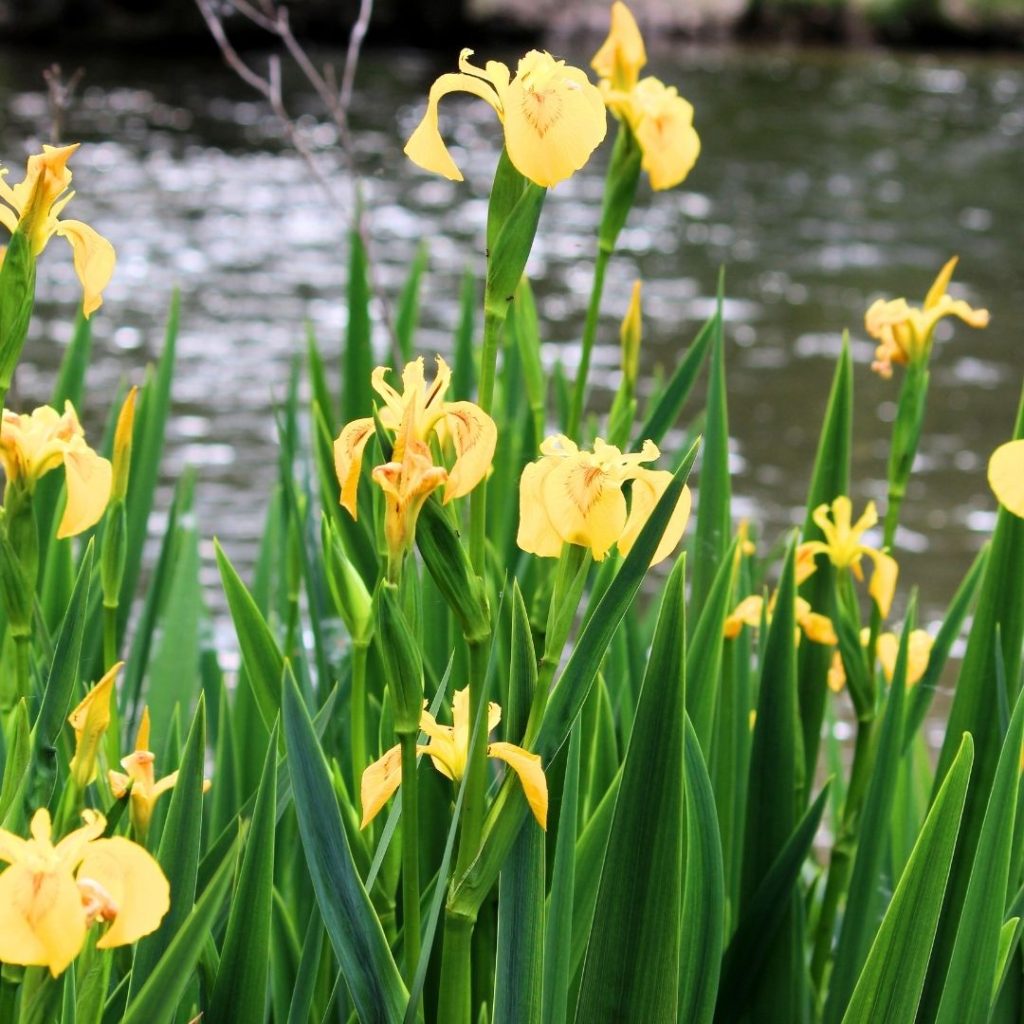
This cheerful cousin of the blue iris establishes quickly at pond edges, creating perfect launch pads for dragonflies.
Its bright yellow blooms stand out against green rushes, guiding dragonflies back to your water feature year after year. It also helps filter water, improving clarity for nymph development.
- Hardiness zones: 4–9
- Companions: Cattail, Pickerelweed, Soft Rush
- Sun/Shade: Full sun
- Attracts: Dragonflies, butterflies
- Repels: Algae (by shading water)
3. Water Mint
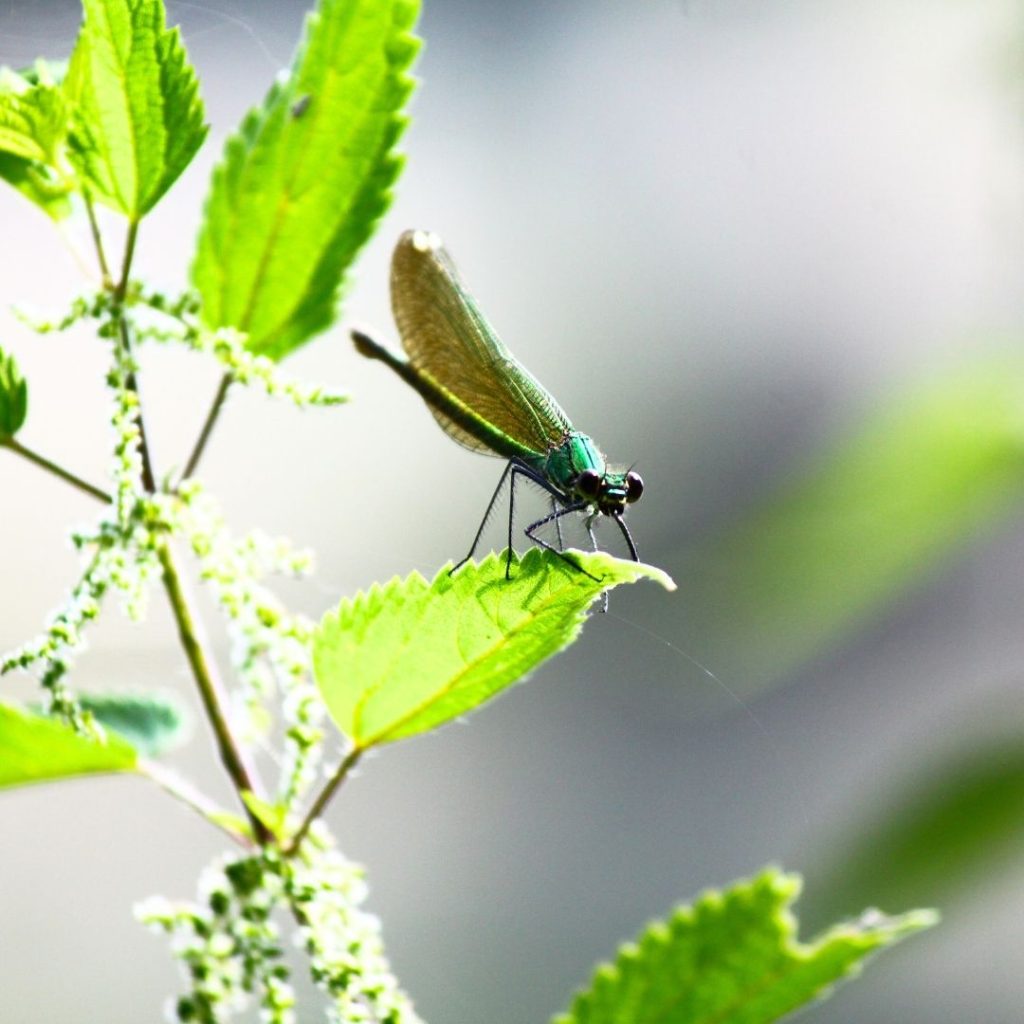
Water Mint’s minty aroma draws bees—and dragonflies swoop in to join the buzz. Plant it in shallow water or moist soil, and enjoy clusters of lavender blooms all summer.
Dragonflies use the low, sprawling foliage as sheltered hunting grounds for mosquitoes.
- Hardiness zones: 3–9
- Companions: Marsh Marigold, Joe-Pye Weed, Sedges
- Sun/Shade: Full sun to partial shade
- Attracts: Dragonflies, bees, hoverflies
- Repels: Some garden pests (aphids, ants)
4. Blue Flag Iris (Top 5 Most Effective)
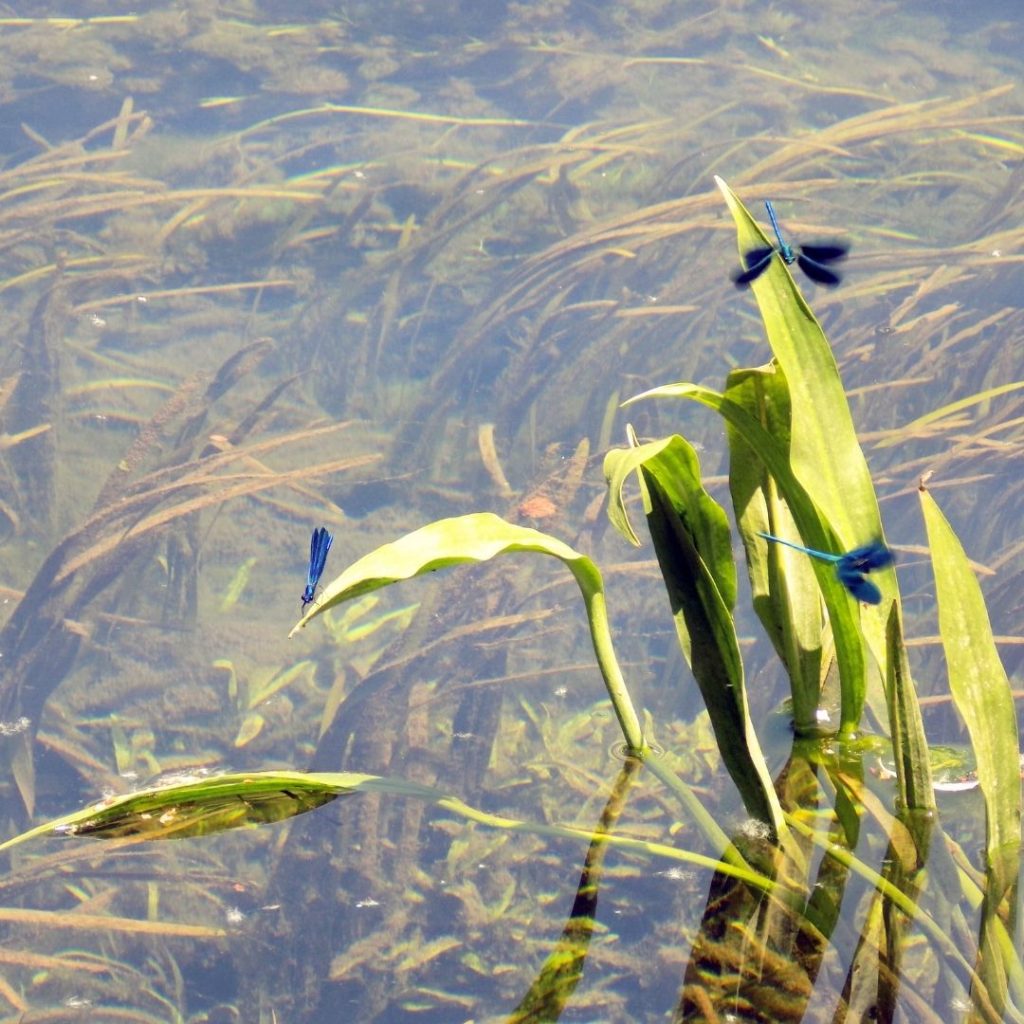
With its striking blue flowers and upright leaves, Blue Flag Iris is a dragonfly favorite. Nymphs clamp to its sturdy stalks when ready to emerge, and adults perch there to dry their wings.
It thrives along pond margins without fuss, providing both beauty and function.
- Hardiness zones: 4–9
- Companions: Marsh Marigold, Cattail, Swamp Rose
- Sun/Shade: Full sun to partial shade
- Attracts: Dragonflies, butterflies
- Repels: Algae buildup
5. Swamp Rose
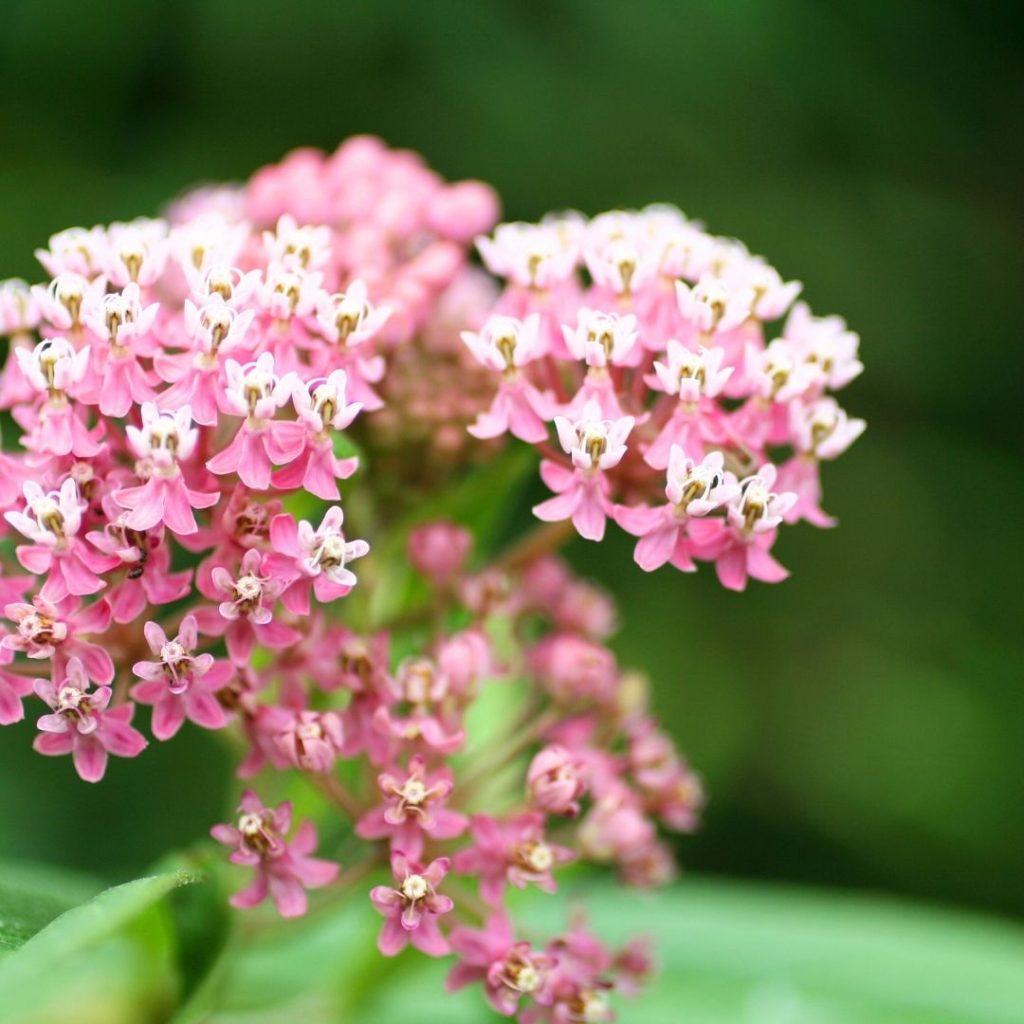
Swamp Rose’s thornless canes and clusters of pink blooms create a dragonfly lookout in damp areas. Bees and butterflies flock to the flowers, and dragonflies patrol the bouquet edges for passing mosquitoes. Its dense thickets also help stabilize soggy banks.
- Hardiness zones: 4–9
- Companions: Joe-Pye Weed, Blue Flag Iris, Sedges
- Sun/Shade: Full sun
- Attracts: Dragonflies, bees, butterflies
- Repels: Erosion (stabilizes soil)
6. Soft Rush (Top 5 Most Effective)
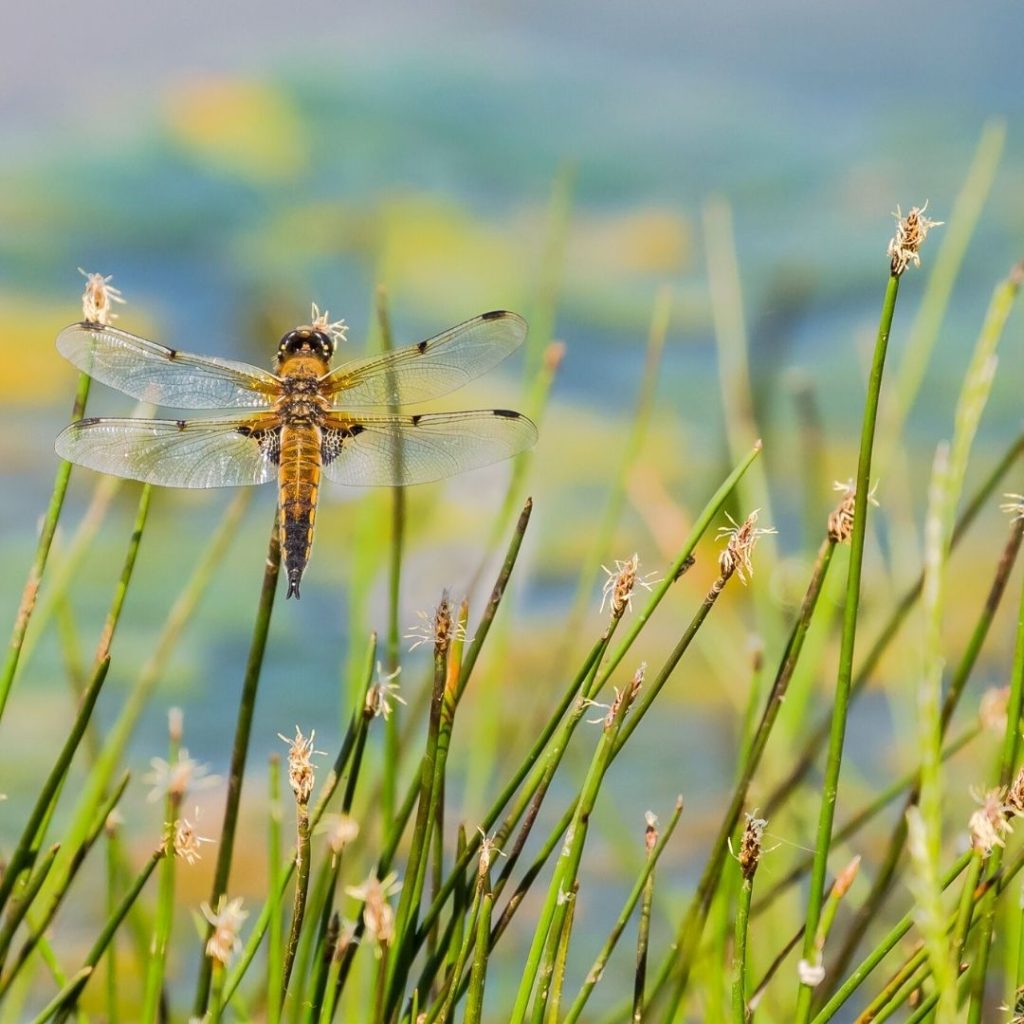
Soft Rush’s tight clumps of stalks are dragonfly nurseries: nymphs crawl up to molt, and adults perch to scan for mosquito meals.
It tolerates sun or light shade, making it versatile for any pond margin. Plus, it filters and oxygenates water, supporting a healthy aquatic ecosystem.
- Hardiness zones: 4–10
- Companions: Yellow Flag Iris, Cattail, Marsh Marigold
- Sun/Shade: Full sun to partial shade
- Attracts: Dragonflies, wetland birds
- Repels: Murky water conditions
7. Obedient Plant
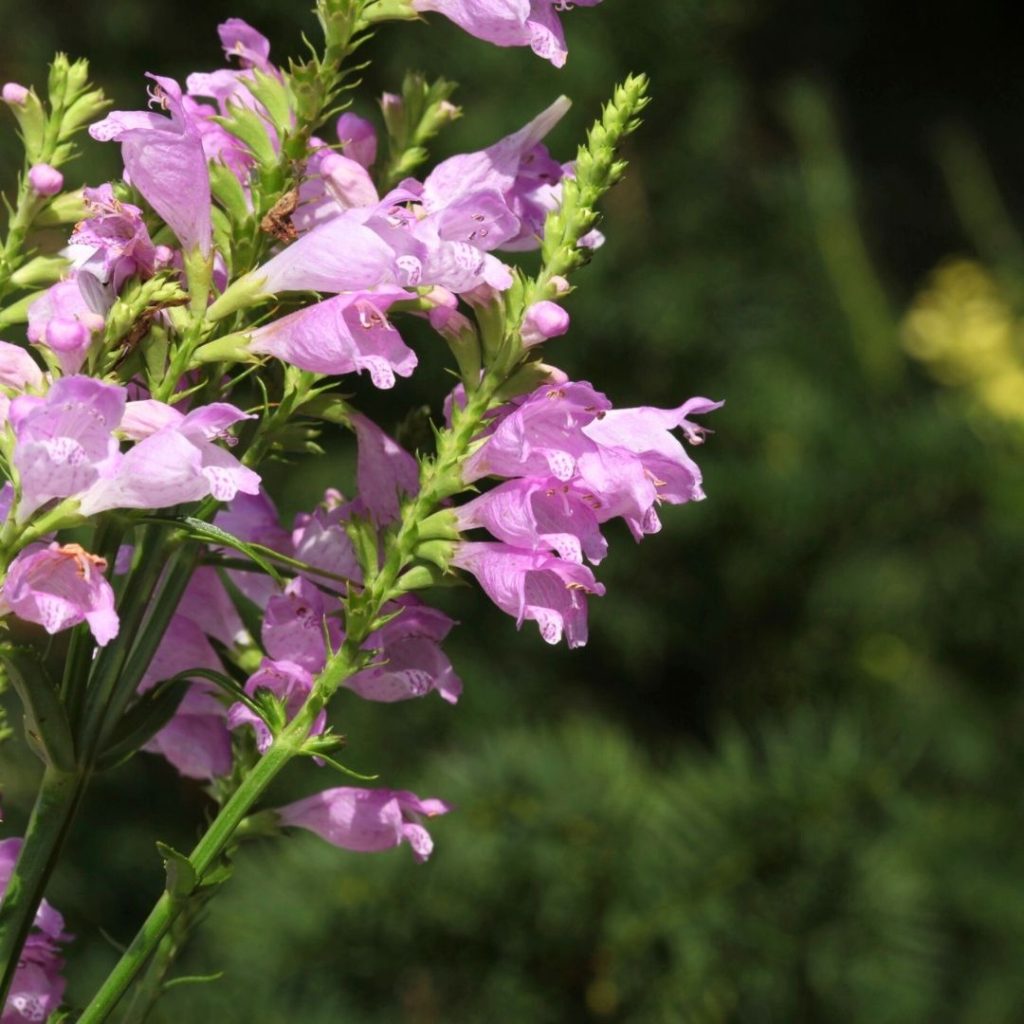
Obedient Plant’s lilac spikes open midsummer, drawing hummingbirds—and dragons drawn by the insect traffic.
Its square stems hold on to blossoms when you shuffle them, earning its name and providing plentiful landing sites.
- Hardiness zones: 4–8
- Companions: Cardinal Flower, Joe-Pye Weed, Ferns
- Sun/Shade: Full sun to part shade
- Attracts: Dragonflies, hummingbirds, bees
- Repels: None specific, but boosts pollinator diversity
8. Pickerelweed (Top 5 Most Effective)
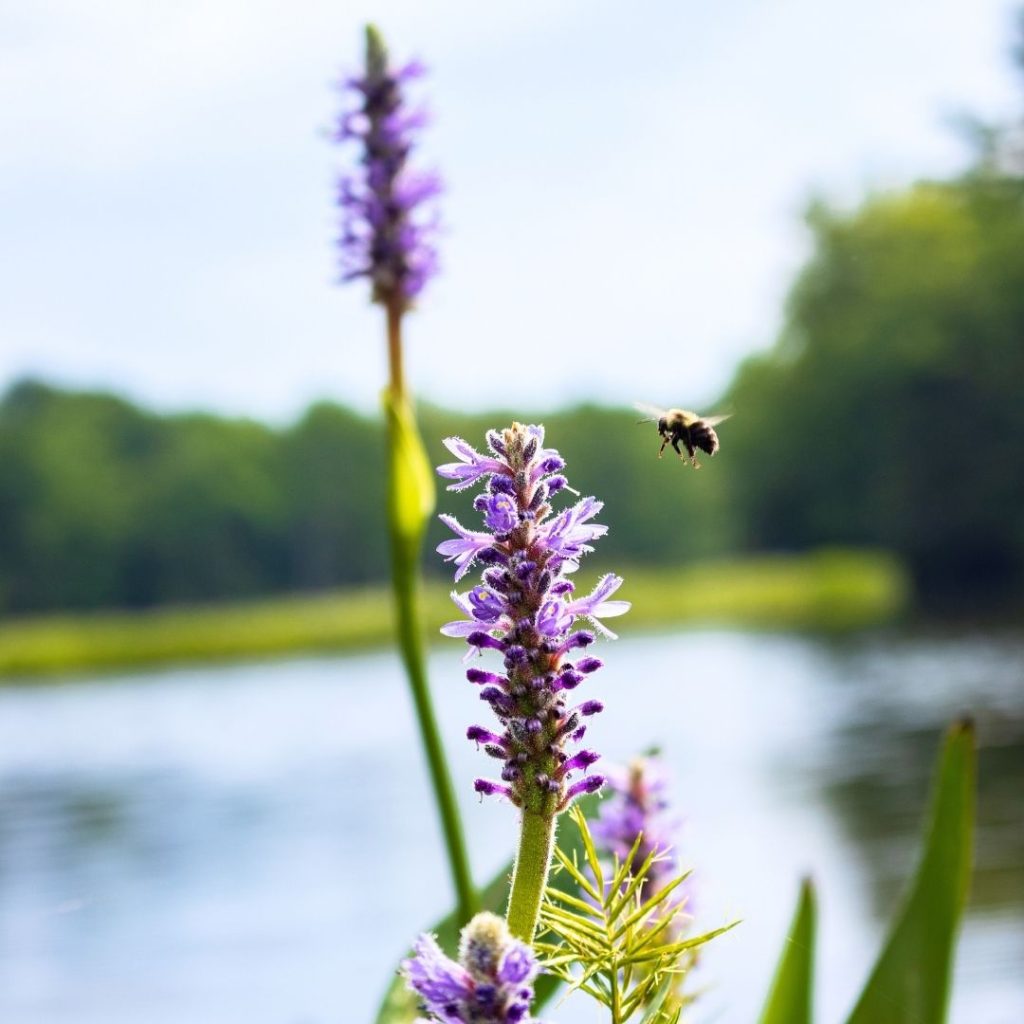
Pickerelweed’s violet spikes poke above still water, offering ideal roosts for dragonflies staking out mosquito larvae below.
Its large leaves shade mosquito breeding areas, and its roots help cleanse standing water.
- Hardiness zones: 5–10
- Companions: Cattail, Yellow Flag Iris, Soft Rush
- Sun/Shade: Full sun
- Attracts: Dragonflies, bees
- Repels: Excess nutrients (by uptake)
9. Sweet Flag
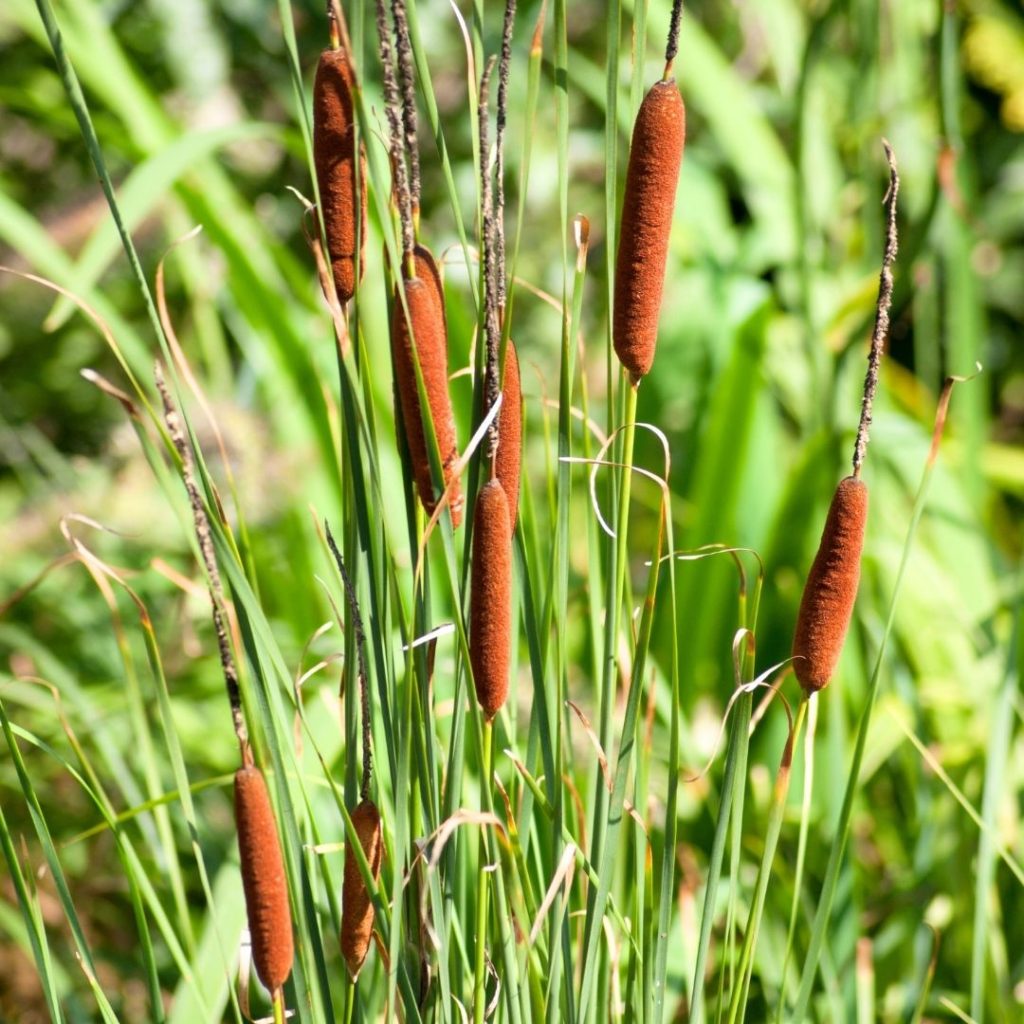
Sweet Flag’s aromatic, sword-like leaves ward off some pests, but dragonflies love to perch atop its sturdy blades. It’s at home in shallow water, bog gardens, or the edges of streams.
- Hardiness zones: 4–10
- Companions: Marsh Marigold, Water Mint, Sedges
- Sun/Shade: Full sun to part shade
- Attracts: Dragonflies, beneficial insects
- Repels: Some soil-borne pests
10. Cattail (Top 5 Most Effective)
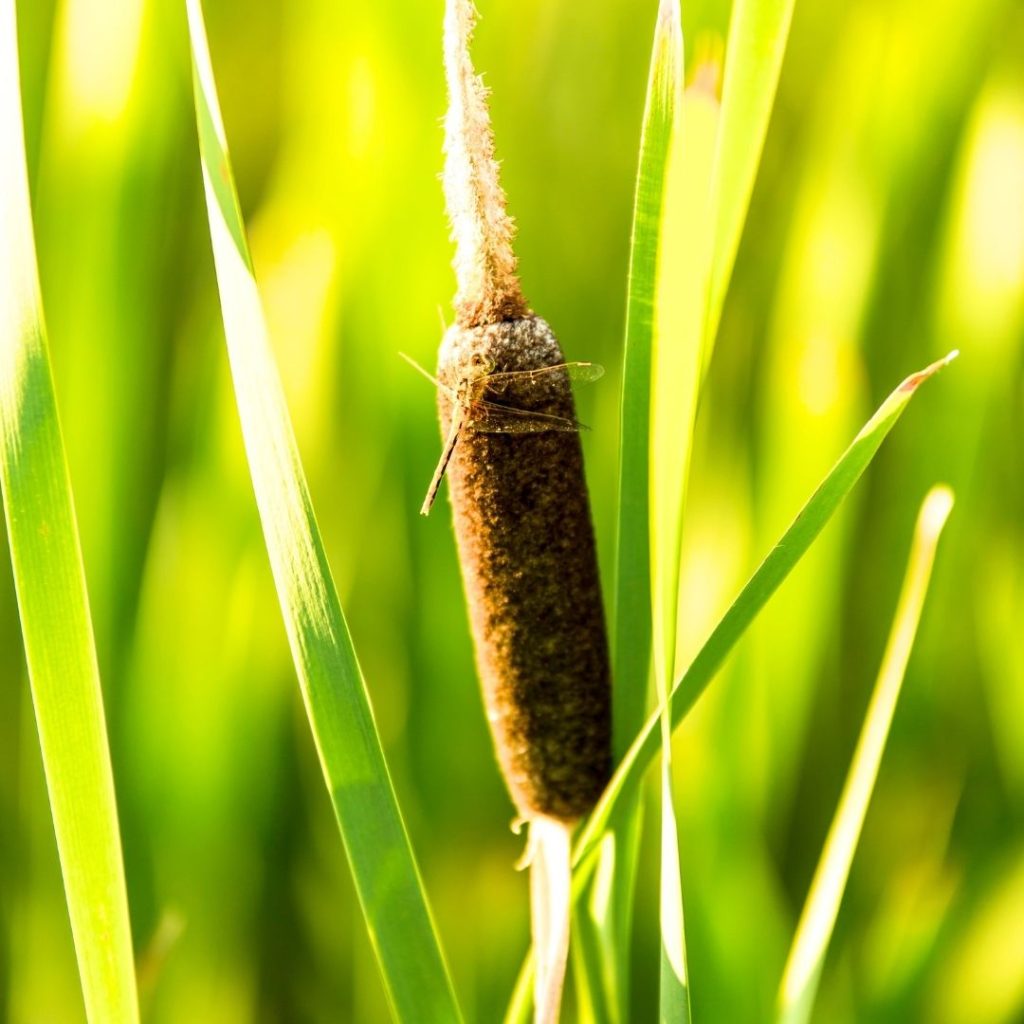
Cattails are a dragonfly superhighway: nymphs cling to their thick stalks to emerge, and adults perch there to survey mosquito-rich waters.
They also filter and oxygenate ponds, improving conditions for aquatic life.
- Hardiness zones: 3–10
- Companions: Soft Rush, Pickerelweed, Blue Flag Iris
- Sun/Shade: Full sun
- Attracts: Dragonflies, wetland birds
- Repels: Sediment accumulation
11. Joe-Pye Weed
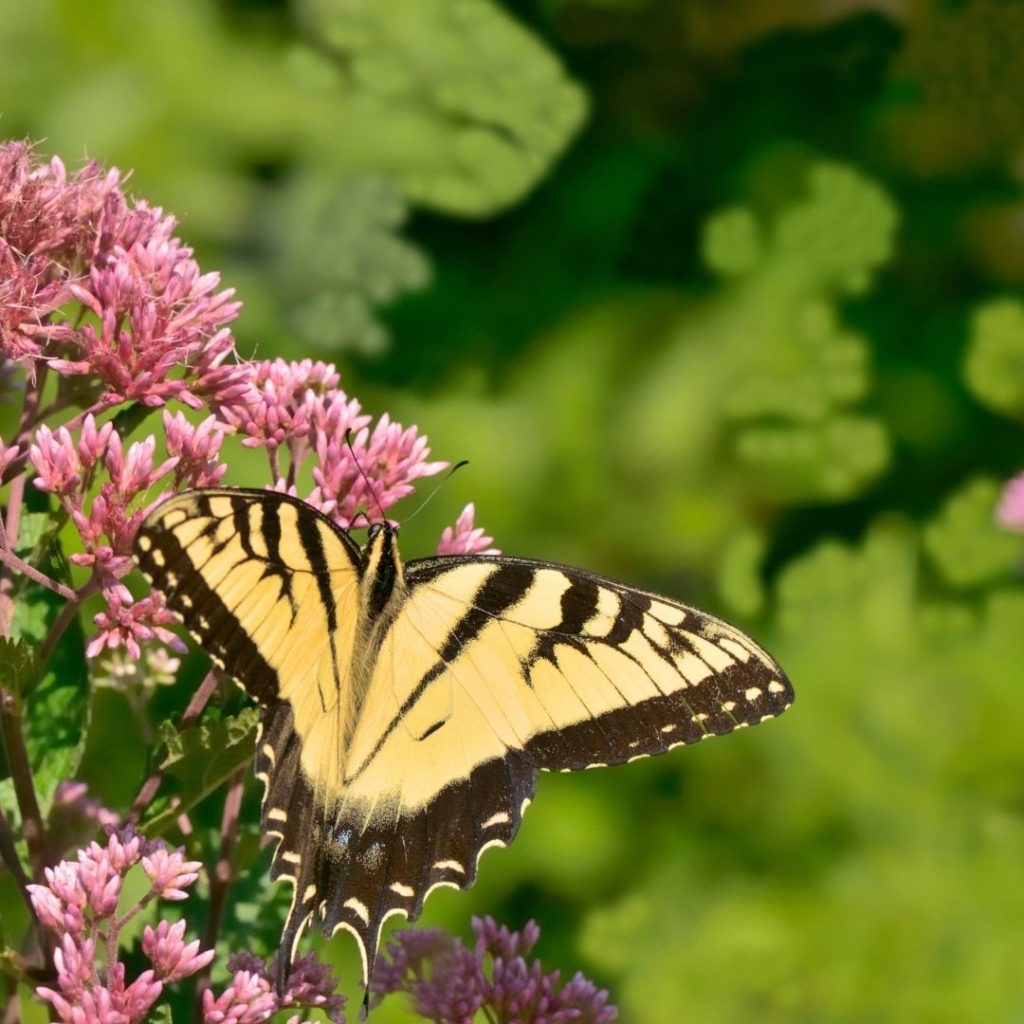
This towering native sports mauve flower clusters that attract bees, butterflies—and dragonflies perched above. Its thick stems give adults sturdy lookouts, while larvae hide below in the moist soil.
- Hardiness zones: 4–9
- Companions: Swamp Rose, Obedient Plant, Sedges
- Sun/Shade: Full sun to partial shade
- Attracts: Dragonflies, butterflies, bees
- Repels: None specific—boosts biodiversity
12. Lizard’s Tail
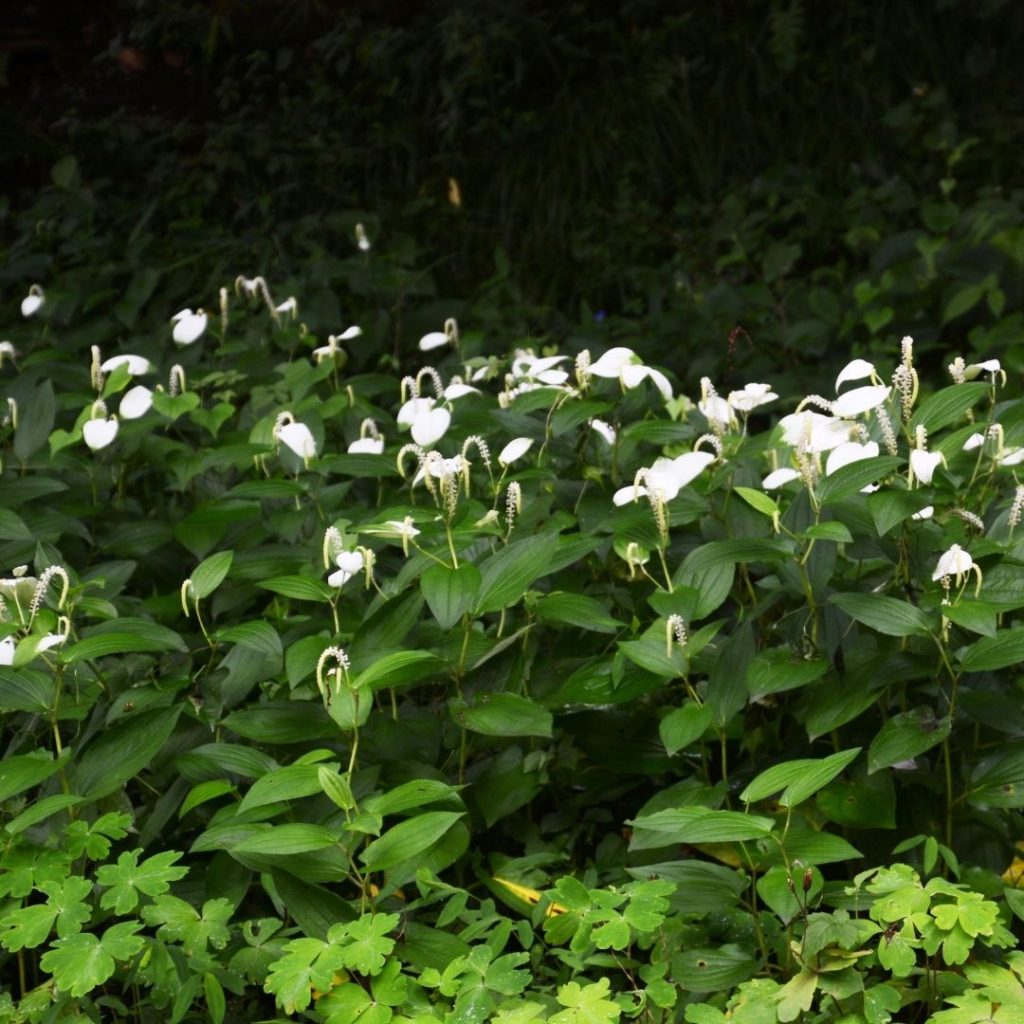
Lizard’s Tail’s arching white flower spikes unfurl along water’s edge, beckoning bees—and the dragonflies that hunt around them.
Nymphs find safe harbor in the submerged rootstocks, while adults perch on the cascading blooms.
- Hardiness zones: 4–9
- Companions: Water Mint, Marsh Marigold, Sedges
- Sun/Shade: Part shade to full shade
- Attracts: Dragonflies, bees, hoverflies
- Repels: Mosquito larvae (by shade and flow)
13. Swamp Milkweed
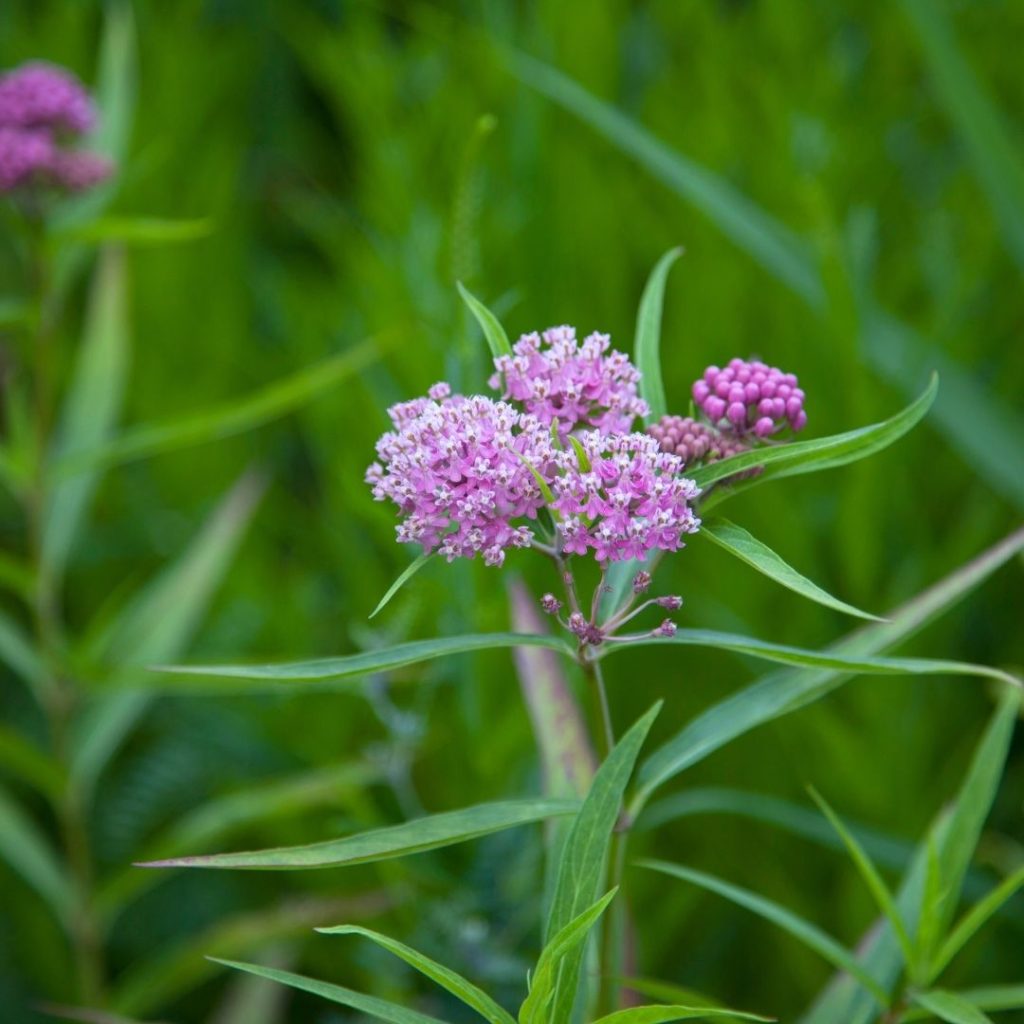
Known for monarchs, Swamp Milkweed also offers dragonflies sturdy stalks to perch on as they patrol for mosquitoes.
Its fragrant flower clusters draw butterflies, creating a lively insect haven.
- Hardiness zones: 3–9
- Companions: Joe-Pye Weed, Cardinal Flower, Obedient Plant
- Sun/Shade: Full sun
- Attracts: Dragonflies, butterflies, bees
- Repels: None specific—supports pollinators
14. Cardinal Flower
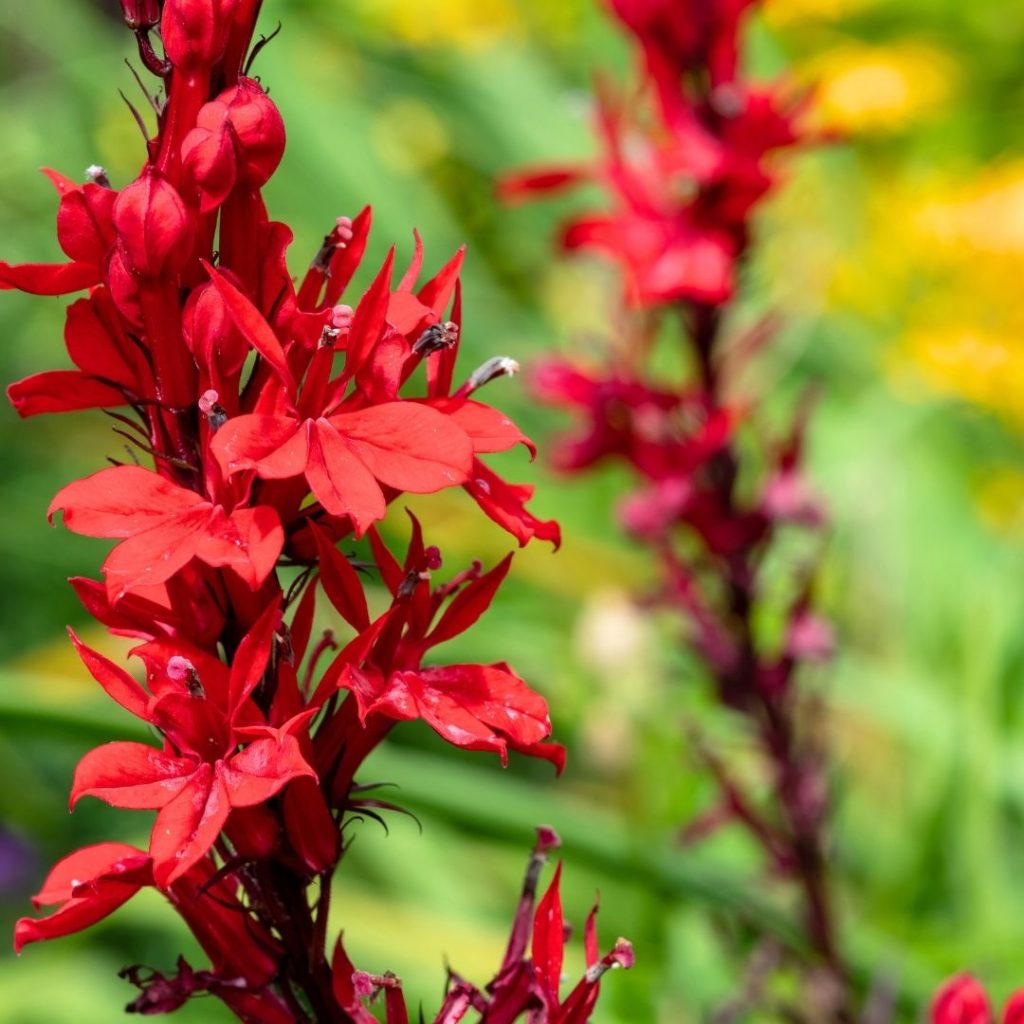
Scarlet spikes of Cardinal Flower lure hummingbirds—and dragonflies follow the hummingbird’s insect flurry.
Plant near moist borders, and enjoy a vibrant splash of red with bonus mosquito control.
- Hardiness zones: 3–9
- Companions: Swamp Milkweed, Marsh Marigold, Obedient Plant
- Sun/Shade: Part shade to full shade
- Attracts: Dragonflies, hummingbirds, bees
- Repels: Mosquitoes (by drawing dragonflies)
15. Great Blue Lobelia
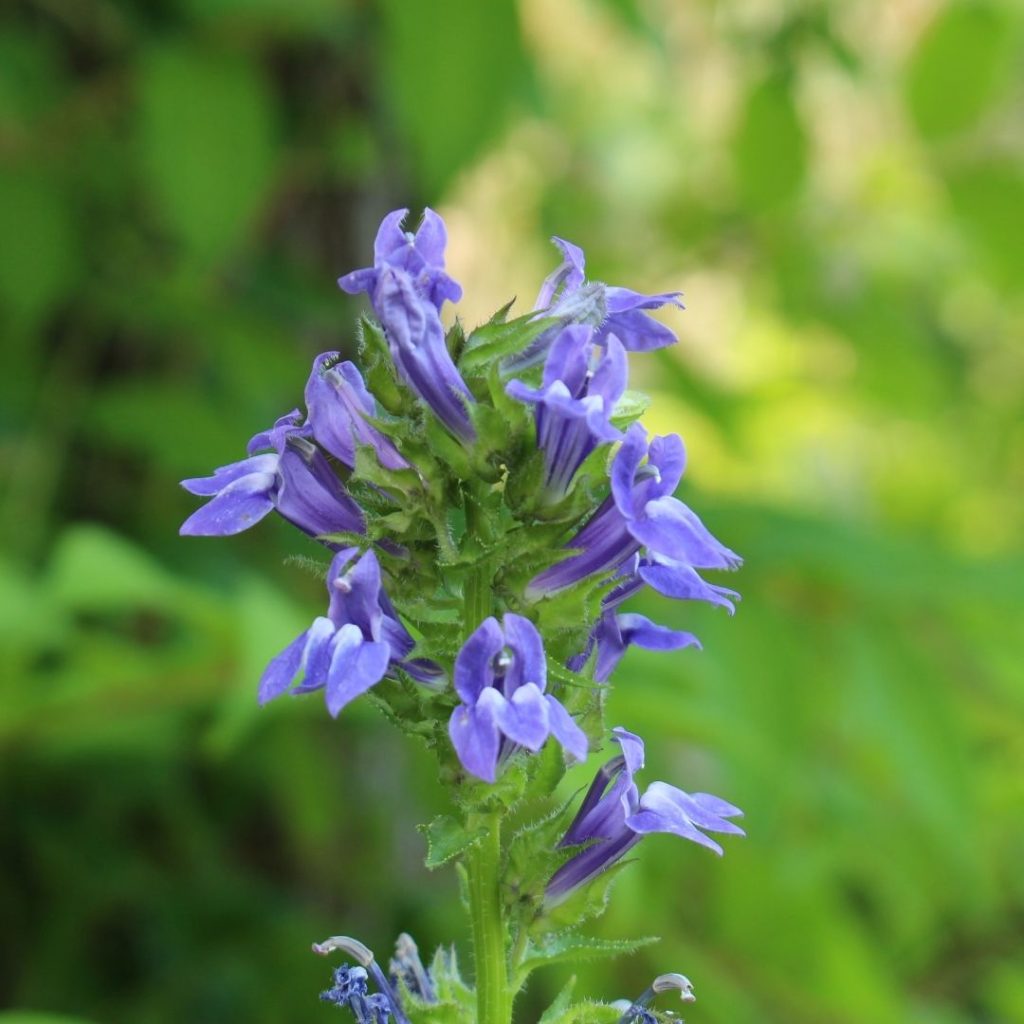
Great Blue Lobelia’s vibrant blue, tubular flowers stand tall above damp soils, offering dragonflies stable perches as they scan for mosquito prey.
The nectar-rich blooms attract bees and butterflies, creating a lively insect corridor that draws dragonflies in search of dinner.
Native to wet meadows and streambanks, it thrives with minimal care and helps filter runoff naturally.
- Hardiness zones: 3–9
- Companions: Joe-Pye Weed, Marsh Marigold, Pickerelweed
- Sun/Shade: Full sun to partial shade
- Attracts: Dragonflies, bees, butterflies
- Repels: Mosquito larvae (by shading and habitat support)
Mosquito Removal 101
Dragonflies can’t eat what was never born. No surprise there. Here’s a practical approach to eliminating mosquitoes, starting with disrupting their breeding cycle.
1. Start by Eliminate Standing Water
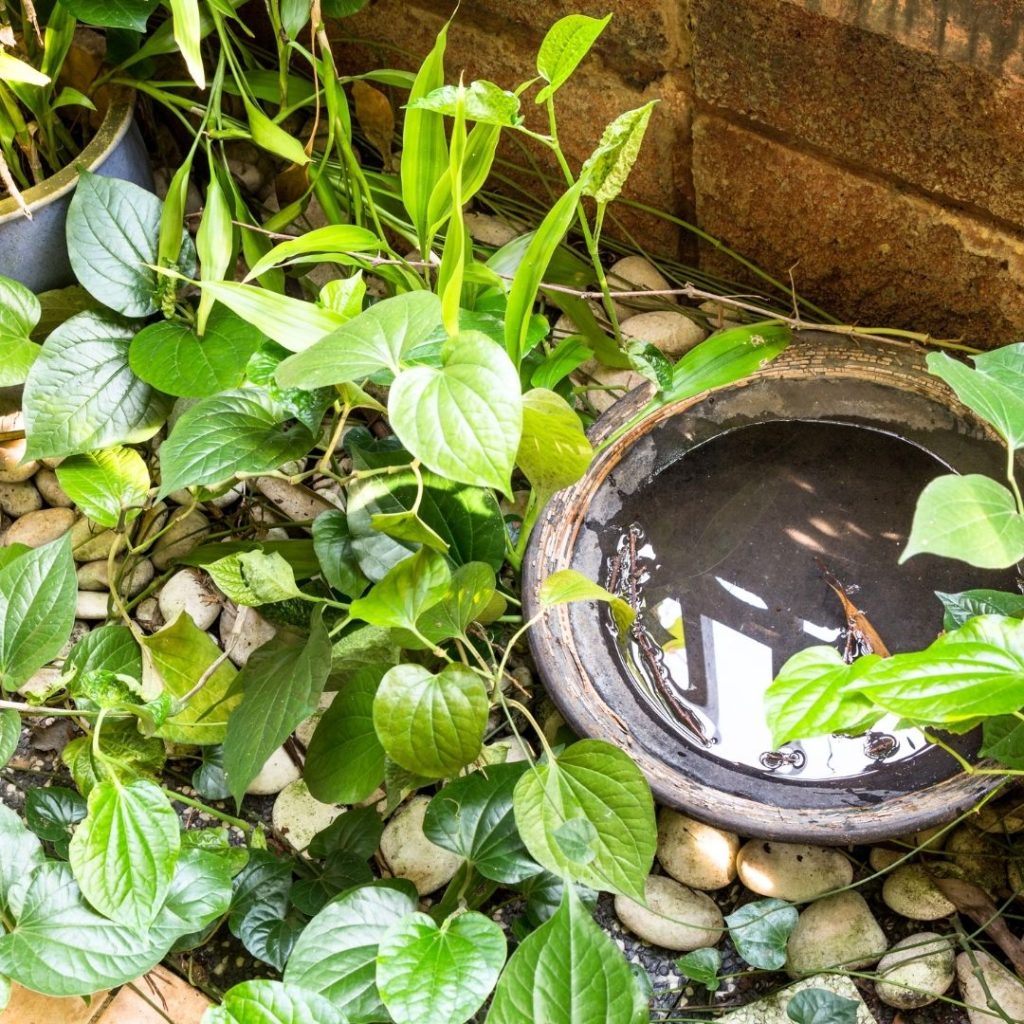
This is the most important thing you can do. Mosquitoes need just a thimble of still water to breed. Walk your property weekly to dump, drain, or treat any containers: flowerpot saucers, birdbaths, toys, and gutters.
For ornamental ponds, install a fountain or aerator to keep water moving; mosquitoes won’t lay eggs in flowing water.
Use larvicidal bits containing Bacillus thuringiensis israelensis (Bti) in ponds or water features. Bti specifically targets mosquito larvae without harming fish, birds, or dragonfly nymphs.
Inspect rain barrels and cisterns; tighten lids and screens to prevent female mosquitoes from entering.
2. Make Your Property As Mosquito UNFRIENDLY as Possible
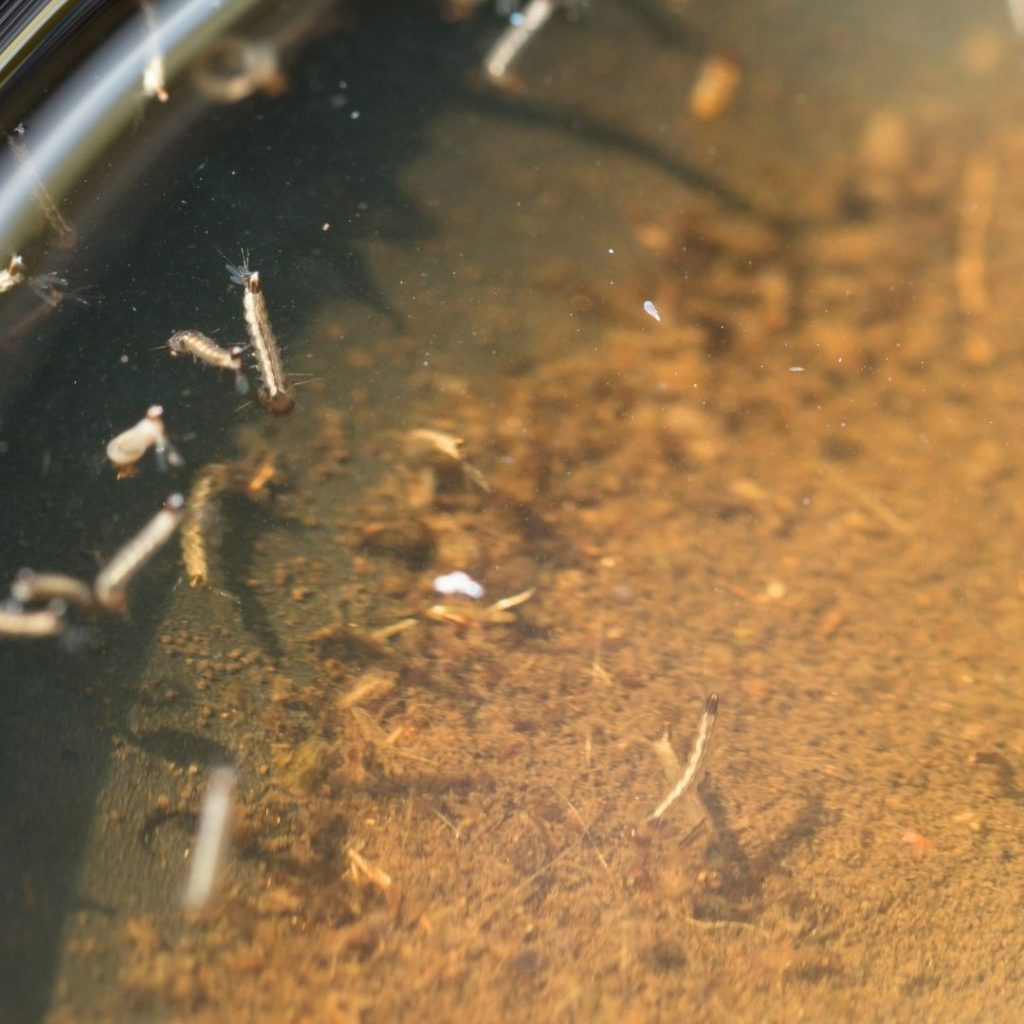
Redirect roof runoff into dry wells or rain gardens planted with moisture-loving natives. These plants absorb excess water, denying mosquitoes breeding sites.
Keep garden beds well-drained and prune back overgrown shrubs to improve sunlight and airflow—mosquitoes thrive in shaded, humid pockets.
If you have low spots that collect water after storms, fill them with gravel or topsoil. For ditches and swales, encourage water flow or plant emergent vegetation that dragonflies favor.
Consistent habitat modification makes your entire yard less hospitable to mosquitoes.
3. Biological Controls
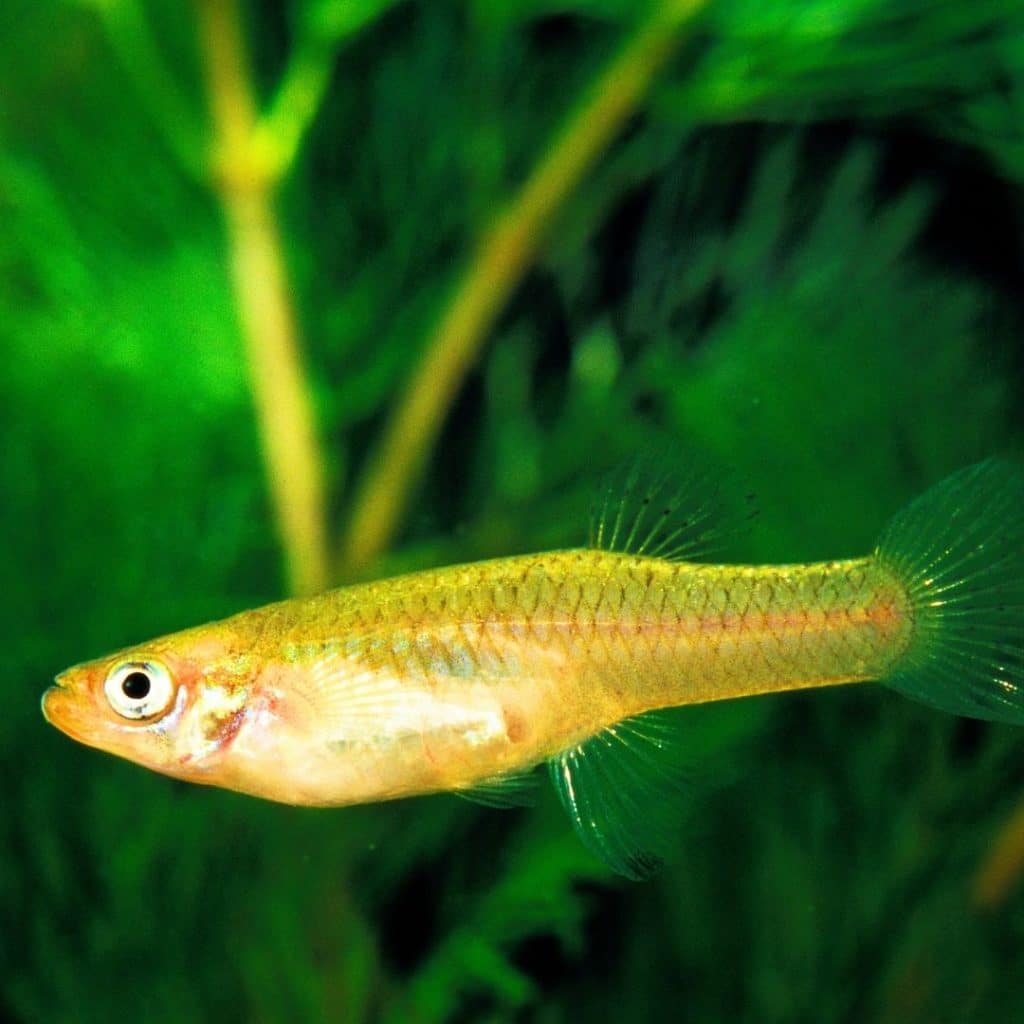
Introduce natural predators beyond dragonflies. Stock ornamental ponds with mosquito-eating fish like gambusia (Mosquito Fish) or golden topminnows; they devour larvae around the clock.
Add predatory copepods (tiny crustaceans) that feed on mosquito wrigglers in rain barrels and birdbaths. Encourage bats by installing a bat box near your garden—they can consume thousands of mosquitoes nightly.
Plant night-blooming flowers such as Evening Primrose and Marigolds to attract moths; bats hunting moths will also catch mosquitoes in the twilight hours.
4. Chemical and Natural Repellents
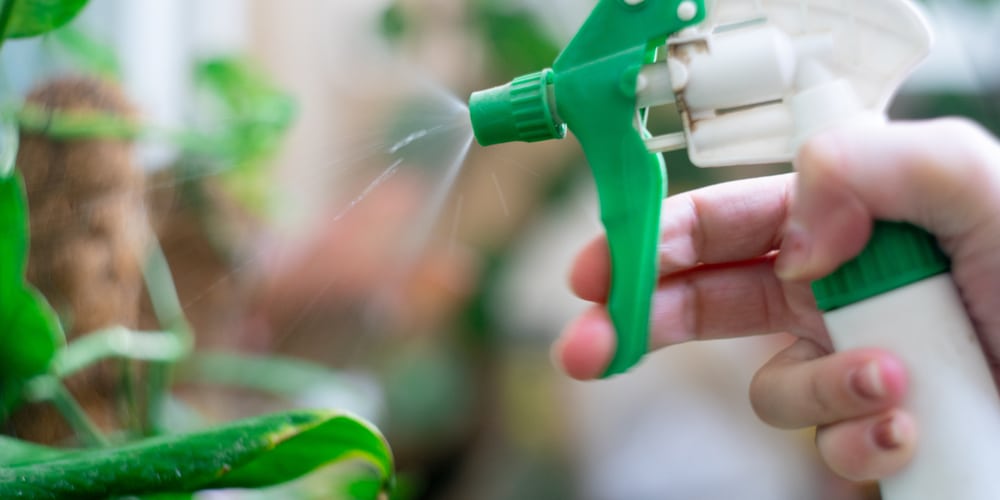
When spending time outdoors, apply EPA-approved repellents containing DEET, picaridin, or oil of lemon eucalyptus for up to eight hours of protection.
For garden perimeters, spray a barrier treatment of Bti granules in puddles and drainages. Consider plant-based foggers with neem oil or essential oils (lavender, citronella, cedar) applied around seating areas—though shorter-lived than synthetics, they add fragrance and modest deterrence.
Avoid broad-spectrum insecticides near water features to preserve dragonflies and other beneficial insects.
5. Physical Barriers and Personal Protection
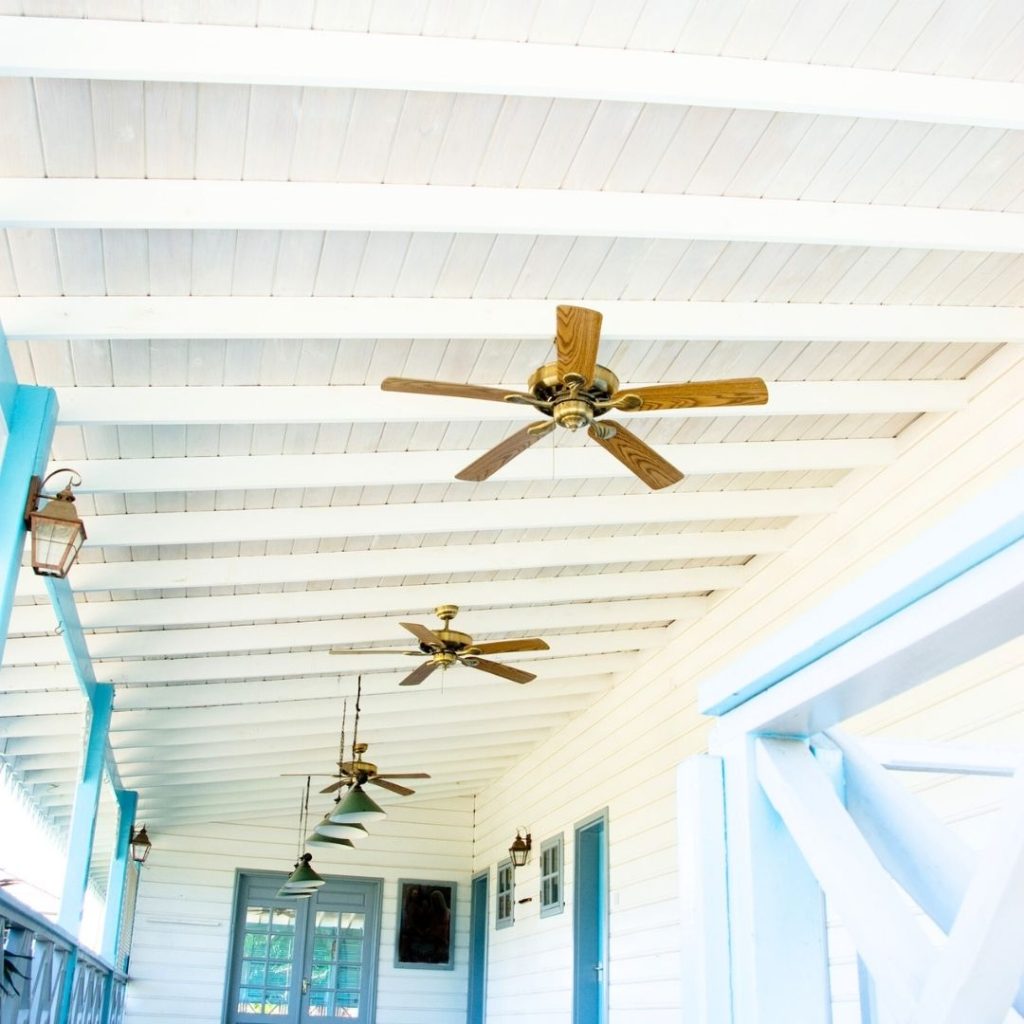
Install fine-mesh screens on windows, doors, and porch enclosures to block mosquitoes from entering living spaces. Use mosquito netting over patios or gazebos for alfresco dining.
Set up oscillating fans on decks and patios—mosquitoes are weak fliers and avoid breezy spots. Wear long-sleeves, pants, and light-colored clothing during dawn and dusk when mosquitoes are most active.
Permethrin-treated clothing and gear offer extra defense on hiking or camping trips. For infant areas, use portable mesh playpens to keep little ones mosquito-free without chemicals.
6. Traps, Lights, and Ongoing Monitoring
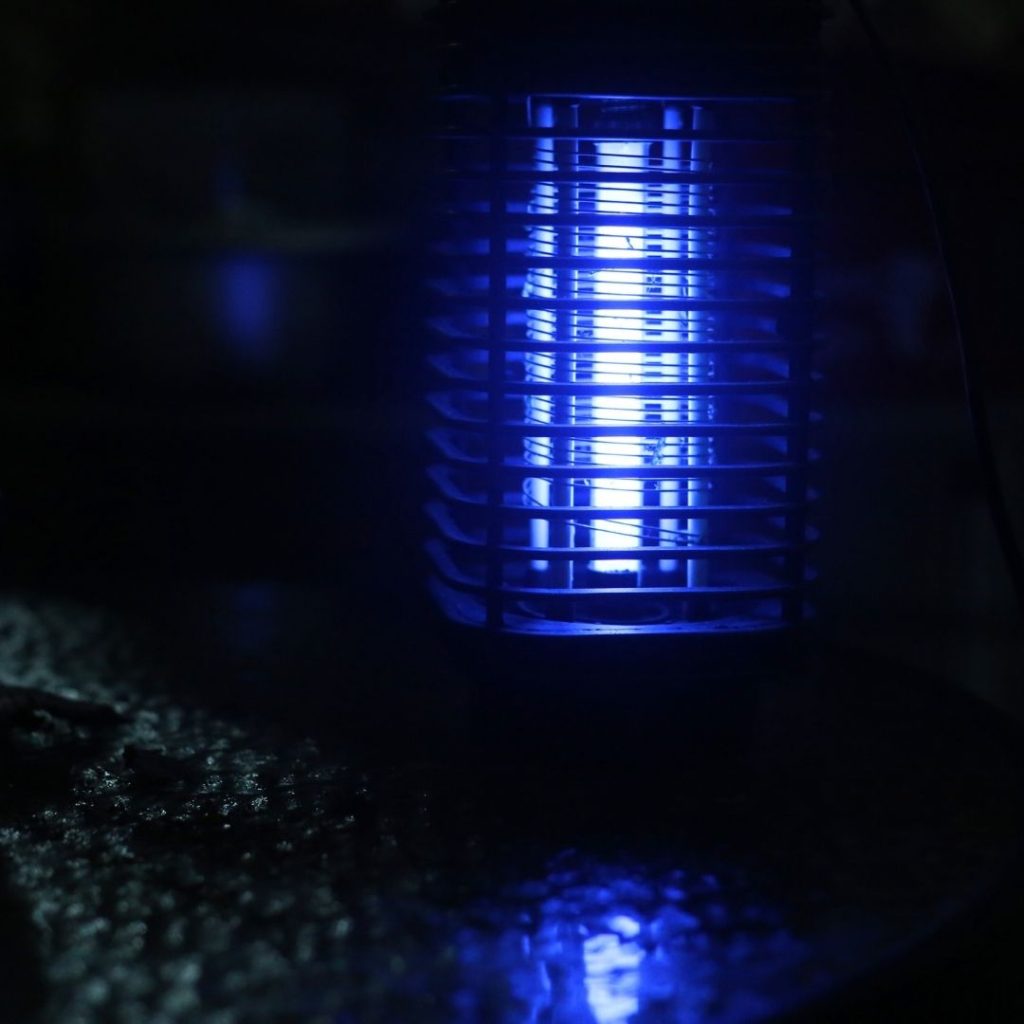
Deploy CO₂ or UV-light mosquito traps downwind of gathering spots; these lure and capture adult mosquitoes selectively.
Check and replace lures or baits as recommended by manufacturers. Install yellow “bug” lights outdoors—they attract fewer mosquitoes than white bulbs.
If you’re going for broke, keep a mosquito log to note peak activity times and conditions—this informs targeted treatments. Adjust your strategy seasonally: early spring habitat elimination, mid-summer trap deployment, and late-season cleanup of leaf litter and debris.
7. Give Up, Call a Pro, and Move on With Your Life (Results may Vary)
No matter what you do, I wish you the best of luck. Thank you for reading—here’s to dragonfly-guarded, mosquito-light summers!